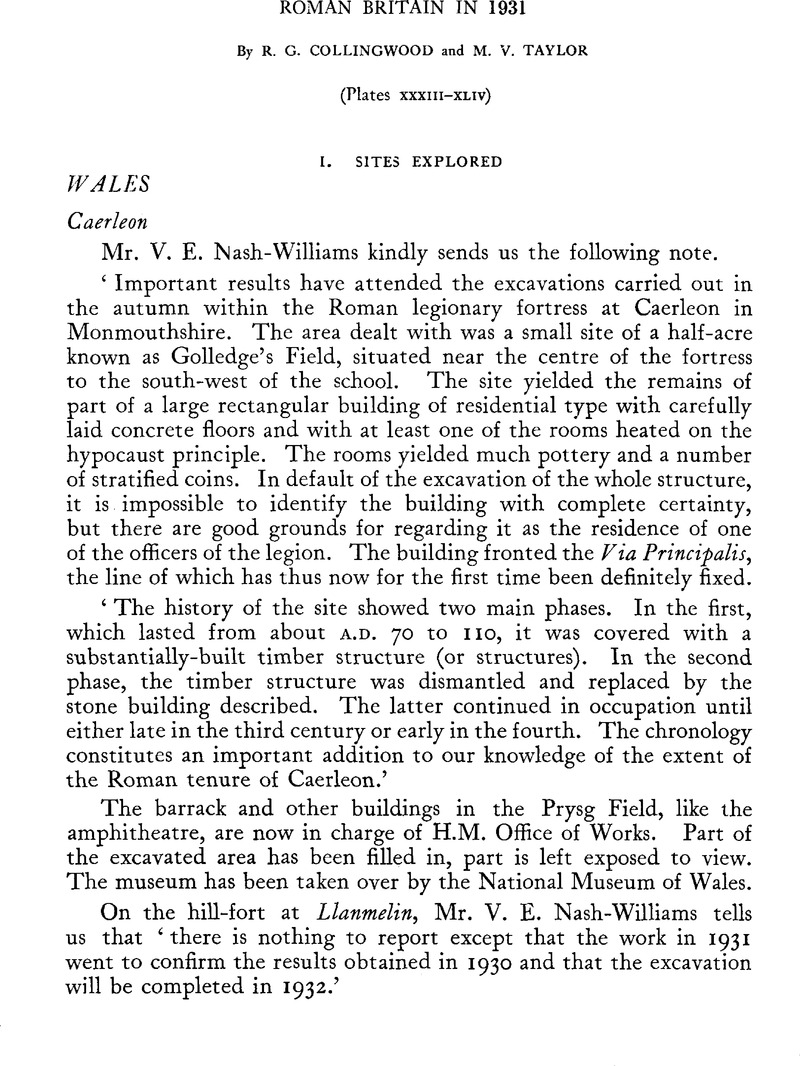Article contents
Roman Britain in 1931
Published online by Cambridge University Press: 24 September 2012
Abstract

- Type
- Review Article
- Information
- Copyright
- Copyright ©R. G. Collingwood and M. V. Taylor 1932. Exclusive Licence to Publish: The Society for the Promotion of Roman Studies
References
page 204 note 1 I am indebted to Mr. C. F. C. Hawkes, F.S.A., for examining tracings and for suggesting these readings.
page 206 note 1 Bushe-Fox, , Excavations at Wroxeter, 1913, p. 44Google Scholar, no. 13; CIL xiii, 10002, 26; xv, 2660; xii, 5683.
page 206 note 2 Wheeler, , The Roman Fort near Brecon (1926), p. 221, 247, nos. 36–38.Google Scholar
page 208 note 1 JRS XXI, 228, fig. 17.
page 208 note 2 JRS XXI, 227, fig. 18.
page 210 note 1 For analogous representations from Frampton and Withington, see Lysons', Reliq. Brit. Rom. i (1813), part 3, pl. vGoogle Scholar; ii (1817), part i, pl. xx; similar examples occur in Gaul and Africa.
page 213 note 1 Roman London (Hist. Mons. Comm.), pl. 55.
page 213 note 2 Cf. ibid., p. 167, fig. 69, no. 60.
page 213 note 3 It may be well to mention that a glass urn, containing the ashes of a woman, similar to those shown in Roman London (Hist. Mons. Comm.), fig. 65, no. 32, and fig. 69, no. 63 found in Union Street, Southwark, probably in 1866, has recently been presented to the London Museum by Dr. Eliot Curwen.
page 214 note 1 See Eph. Ep. ix, p. 159, nos. 1283, 1284. Report published in Bristol and Glouc. Arch. Soc. Trans., vol. liii (1931).
page 218 note 1 Num. Chron. 1931, p. 233.
page 218 note 2 An account is published in the Berks. Arch. Journ. vol. xxxvi.
page 218 note 3 An account is published in the Newbury and District Field Club Transactions, 1932.
page 219 note 1 An account is published in the Sussex Arch. Collections lxxii, p. 265 ff.
page 222 note 1 It measures at ground level 146 by 106 ft. including a projecting flange 12 ft. broad and 5 ft. thick; the central part measures 126 ft. by 81 ft. See JRS xix, 212; xx, 246.
page 223 note 1 For similar coins in a hoard at Lydney, which is dated tentatively to the fifth century, see Soc. of Antiqs. Research Reports, no ix (1932), p. 125 ff.
- 1
- Cited by


